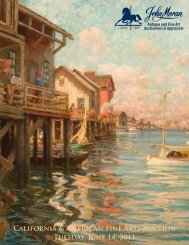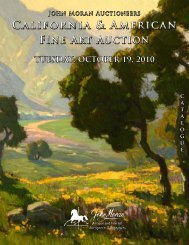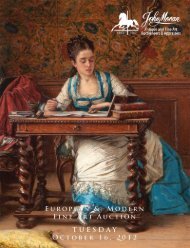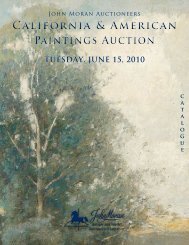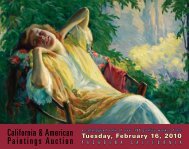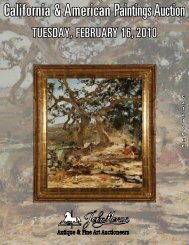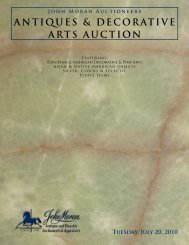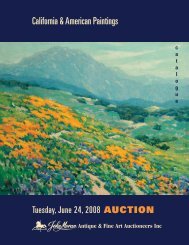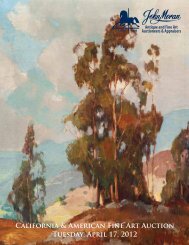Tuesday, JuLy 22, 2008 - John Moran Auctioneers
Tuesday, JuLy 22, 2008 - John Moran Auctioneers
Tuesday, JuLy 22, 2008 - John Moran Auctioneers
You also want an ePaper? Increase the reach of your titles
YUMPU automatically turns print PDFs into web optimized ePapers that Google loves.
1109 Lyonel Feininger (1871-1956 New york, Ny/Germany)<br />
“Die Teufelssonate”, signed and dated upper right: Feininger 08, ink on paper<br />
under glass, image size: 13.5’’ x 12.75’’, est:$20,000/30,000. Literature: Berliner<br />
Illustrirte Zeitung, 19 February 1911, illustrated on the cover. Note: This 1908 drawing<br />
demonstrates a pivotal shift in Lyonel Feininger’s artistic career. Between 1906 and<br />
1908, Feininger transformed himself from a master caricaturist into an exemplary<br />
painter. Working in Berlin and Paris, he was greatly influenced by his French peers<br />
and tried to suppress his affinity for cartooning and illustration just when he had<br />
reached the pinnacle of his career in these fields. The verticality and attenuated<br />
forms in the drawing are adaptations of certain elements of the Art Nouveau<br />
movement which just a few years later he would amplify to greater extremes.<br />
The subject matter is autobiographical, with something of a psychological twist.<br />
Feininger’s parents, both musicians, impressed upon their son their belief in the<br />
superiority of music over applied and fine arts. According to a 1905 letter excerpt<br />
published in E. Scheyer, ‘’Lyonel Feininger: Caricature and Fantasy’’, Detroit, MI,<br />
1964, p. 13, ‘’I remember so well: When I was a very small boy, four or five years<br />
old, in New York, we lived in a three story house all by ourselves: I used to sit in the<br />
dusk in the big dining room in the basement. The large stove gave heat also to the<br />
music room above. The register of the stove was open for me so that I might hear<br />
the better - than there I was - perfectly entranced, while my parents were playing,<br />
my father the violin, my mother accompanying him on the piano, music by Bach,<br />
Beethoven, Mendelssohn, Schumann, Schubert. Waves of delight went through me<br />
- I believe nobody ever had an idea what was happening with me: later anyhow my<br />
father didn’t consider me to be deeply musical. But maybe my inclination for technical<br />
constructions, which then had the upper hand, was not very favorably looked upon<br />
by my father, I tinkered too much for his taste - he didn’t like it, that I was able to drive<br />
pins so straightly into the wooden models which I was building all the time - miniature<br />
ships, locomotives and such - he seemed to think that this precluded all feeling for<br />
art.’’<br />
Feininger’s parents traveled together extensively on musical tours and he and his<br />
siblings were left with relatives and family friends for long periods of time, resulting<br />
in feelings of despair and isolation. ‘’In moments of loneliness ‘he imagined faces<br />
lurking in the moving shadows’ under the elevated [train] and was haunted by “ghostlike<br />
apparitions and forms not of this world.’’ (ibid, p.19).<br />
The Devil’s Sonata, or Devil’s Trill Sonata (Il trillo del diavolo) was composed by<br />
Venetian violinist Giuseppe Tartini (1692-1770). The story goes that Tartini one night<br />
dreamt that the devil appeared at the foot of his bed, asking to be his student. Tartini<br />
proceeded to play his violin and at the end of his instruction, he handed the devil<br />
his instrument to test his skill. The devil began to play with such virtuosity a sontata<br />
so beautiful, complicated and technical that Tartini immediately awoke with a gasp<br />
and attempted to play what he had just heard in his dream. He transcribed the<br />
composition as best as he could remember it but claimed it fell far short of what<br />
the devil played for him. As he told the French astronomer Jerome Lalande, who<br />
recorded the story in his ‘Voyage d’un francois en Italie’, 1769, ‘’The piece I then<br />
composed is without doubt my best, the Devil’s Sonata, but it falls so far short of the<br />
one that stunned me that I would have smashed my violin and given up music forever<br />
if I could but possess it’’.<br />
The theme of the looming violinist recurred in Feininger’s later oeuvre, as in ‘’The<br />
Virtuoso’’, circa 1920 and ‘’Der rote Geiger’’ of 1934.<br />
Together with original cover page from Berliner Illustrirte Zeitung with the present<br />
work illustrated.<br />
This work will be included in the Lyonel Feininger archives of drawings and<br />
watercolors, certificate number <strong>22</strong>0-5-3-08. Provenance: Acquired in Germany no<br />
later than the 1930s, by descent in the family to the present owner; Property from the<br />
Marianne J. Knox Trust, Los Angeles, CA Condition: Visual: The drawing in generally<br />
good condition. Two small tears along the upper edge, 0.5’’ and 0.25’’, a 0.5’’ tear<br />
with tape backing it along the upper left edge and a 0.25” tear along the right center<br />
edge. Paper is slightly rippled. Paper margins are toned and stained and with tears<br />
throughout and missing paper to the edges. Newspaper clipping is mounted to a nonarchival<br />
board and is heavily toned.<br />
26




